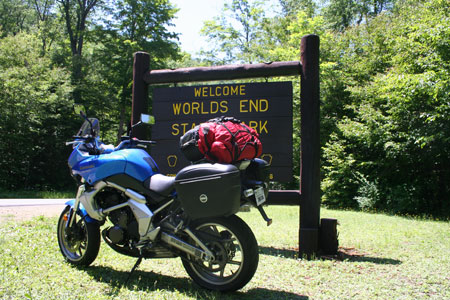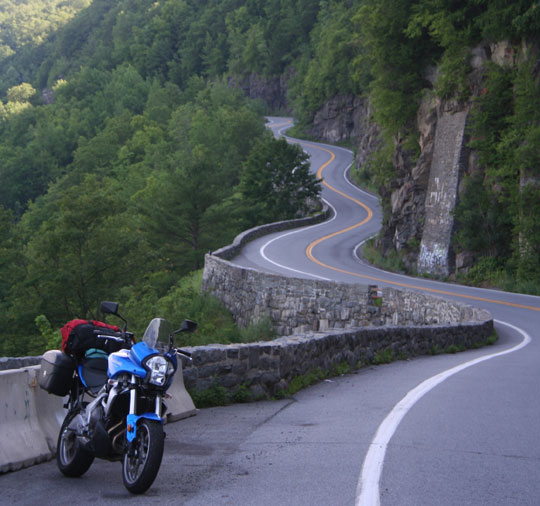Two years ago today, I bought a leftover 2009 Kawasaki Versys. I can say with certainty that while it’s not the best motorcycle I’ve ever owned, it’s the best motorcycling bargain I’ve ever scored.
Read the update:
Four years on a Kawasaki Versys
The so-called Great Recession was a great time to buy a new motorcycle, if you were fortunate enough to have any money to do so and felt confident enough about your income stream to pull the trigger. Sales plummeted in the aftermath of the collapse of the housing bubble and new motorcycles languished on dealers’ sales floors long after they should have moved out the door.
It so happened that I was in need of another motorcycle in 2009. My Speed Triple had topped 80,000 miles, and while it was still fairly reliable, touring on it had always required extreme forms of improvisation in packing. My Daytona 675 is a great track bike, but forget about long trips. So I wanted something relatively lightweight and inexpensive that could be fitted with waterproof, lockable luggage and would be comfortable enough for long trips. Since I do a lot of work for Accelerate, the Riders of Kawasaki magazine, it would be good to have a Kawasaki, too. It didn’t take much research or shopping around to find that incredible deals could be had on a Versys.

I always wanted to be able to say I’ve ridden to the ends of the earth. I had to settle for Worlds End State Park.
I eventually bought this blue, 2009 Versys at Honda East in Maumee, Ohio, on May 29, 2010, for $5,350 out the door, including sales tax. I immediately put on Givi racks and E21 saddlebags for a shade under $400, rode it around 500 miles so I could do the break-in oil change, and then loaded it with camping gear and set off for my annual trip to Maine less than two weeks after I bought it. I always wanted to say I’d ridden to the ends of the earth, but I had to settle for stopping by Worlds End on the way. Still, in less than one month of ownership I put more than 3,000 miles on the Versys.

The beautiful curves of Hawks Nest, New York, on Route 97.
Of course that pace was not destined to last, but I have racked up steady miles in the two years since with two additional trips to New England, two trips to Indianapolis for MotoGP, numerous rides to the old family homestead in West Virginia, runs to the hardware store, and just about any other daily transportation need. Over that time, the only additional changes to the bike have been Acerbis handguards and Symtec heated grips to try to keep my hands from freezing solid in the winter, since the Versys instantly became my all-weather bike.
Over these two years and approximately 20,000 miles, I’ve come to know the strengths and weaknesses of the Versys.
Pros:
- Cheap to buy, insure and maintain. Mileage can top 50 mpg under good conditions, and even when hammering down the interstate it stays in the mid-40s.
- Nimble handling. The 17-inch tires and sub-500-pound weight keep the bike maneuverable and fun to ride, even when it’s loaded for the road.
- The upright seating position is comfortable enough to ride all day. So far, my longest day has been around 720 miles.
- Surprisingly good two-up. The Versys handles the additional weight with less degradation in the handling department than I expected.
Cons:
- Though the Versys is a great bargain (especially for the price I was able to pay), it does show signs of corner-cutting. The fairing buzzes annoyingly. I fixed that with some weather stripping, but after two years the buzz is back. I could fix it again, but since I always wear ear plugs, I’m considering just ignoring it instead. Another minor gripe is that the brakes feel weaker than, for example, my two Triumphs, though they get the job done.
- That all-day comfort I mentioned above? The only caveat is the seat, which is a common complaint among Versys owners. Personally, I think it’s fine for about 100 miles. On longer trips, I use an Airhawk seat pad, which lets me ride all day.
- The handling is sweet, as mentioned above, but the Versys does feel a little tall and top-heavy. That’s the one thing that holds me back from recommending it to new riders. Unless they’re 6-5.
Experienced riders tend to ask me if the Versys has enough power. Here in the United States of Bigger is Better America, a lot of people have the idea that you can’t tour on a “little” 650. The engine in the Versys is tuned for midrange power, which works well in the kind of daily-driver, sport-touring mode I use it for. I won’t be drag-racing ZX-14s, but I hardly even have to rev into the middle of the powerband to quickly separate myself from 99% of the cars on the road when the light turns green and I want to extricate myself from the chaotic cluster of city traffic.
I happen to admire and love bikes like the Kawasaki Concours 14, which may well be the epitome of a sport-touring bike (depending on how you define sport-touring, which is a very personal opinion that can range widely in terms of sport vs. touring). It’s comfortable, powerful, nimble for its weight and is packed with technology and convenience features.

Visiting the “Grand Canyon of the East” in Pennsylvania on my Versys.
But I decided long ago that I would be happier if I never again bought a motorcycle that weighed more than 500 pounds. Weight is the enemy. It makes everything, from brakes to suspension to engine to rider, work harder.
I happily decided to give up the shaft drive, electrically adjustable windshield, remote tire pressure sensors, keyless ignition and other technological gee-whizzery in order to save a couple hundred pounds and drop the purchase price by two thirds. Others prefer the full-luxury route, and I don’t blame them. After all, I’m not saying the Versys is best motorcycle ever. But at under $6,000, fully farkled and ready for the open road, my Versys is the best bargain I’ve found yet.
Postscript: Thinking about a Versys? The community at the Versys forum is more helpful and friendlier than most.
